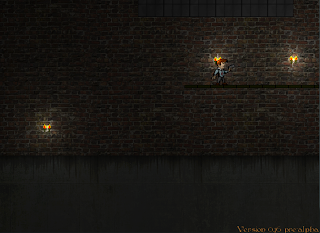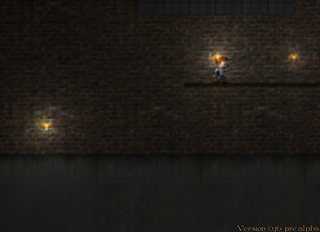This week, I've got some minor updates done. With midterms and projects across the board, it's been a pretty insane week, and not much progress has been made on the game visually. Behind the scenes, I've got some code-restructuring, and the beginnings of an enemy class. On the visual side of things, I've got a new game-play mechanic to show off!
While tweaking the time-trail algorithm, I realized that a particularly clever player could stand in a very bright area for an extended period of time to cast himself further into the future, then just skip throughout the level unnoticed by enemies while his past self slowly trudged through the layers of time. As I wondered about how to fix this, I realized that I had a couple of Gaussian blur shaders already implemented for when I was testing post-processing in
my rendering engine. So I decided to test what it would be like if the player was faced with an increasing blur of the world around him as he traversed through time.
Here are a couple of screenshots showing the differences:
 |
 |
| A small delay, ~1 second |
A much larger one, ~10 seconds |
The idea is that the player will not be able to accurately see what's going on in the level as the blur increases, and thus will be deterred from traveling a large amount into the future.
Algorithm Details
For the time-trail algorithm, I created a method called CWorld::CalculateLightInfluence(). It, aptly named, calculates the sum of the three most-influential light sources. It used to rely on distance, but that only makes sense if all of the lights have the same attributes, so now the actual influence is calculated and compared for all of the lights. The calculation is as follows:
distance * 200.f / (Constant Attenuation + Linear Attenuation * distance + Quadratic Attenuation * distance2) * brightness
This is almost the same as the algorithm I use in my lighting shader, except it's done on a single light rather than every pixel of the entire screen, heh. I can easily tweak the 200.f constant if I want lights to have more or less of a cumulative influence. So, this value is summed, capped at a range of [0, 5), and returned to the world for further processing.
Back in CWorld::Update(), this value is then used to create time-trail instances. After this, the blurring algorithm is performed. It determines the total time between the current time and the time-trail active at the moment. This represents the amount of time ahead the player is. This value is divided by 10000, because the Gaussian Blur shader only works well with really small radius values. It's clamped to [0, 1/300]. The larger the value, the closer it is to the limit, and thus the blur increases!
I want to tweak this to be a progressive algorithm, rather than just a linear increase. In the near future, I'll make a spread-sheet and maybe apply a increase based on a stretched out x2 graph, like maybe x2/8




